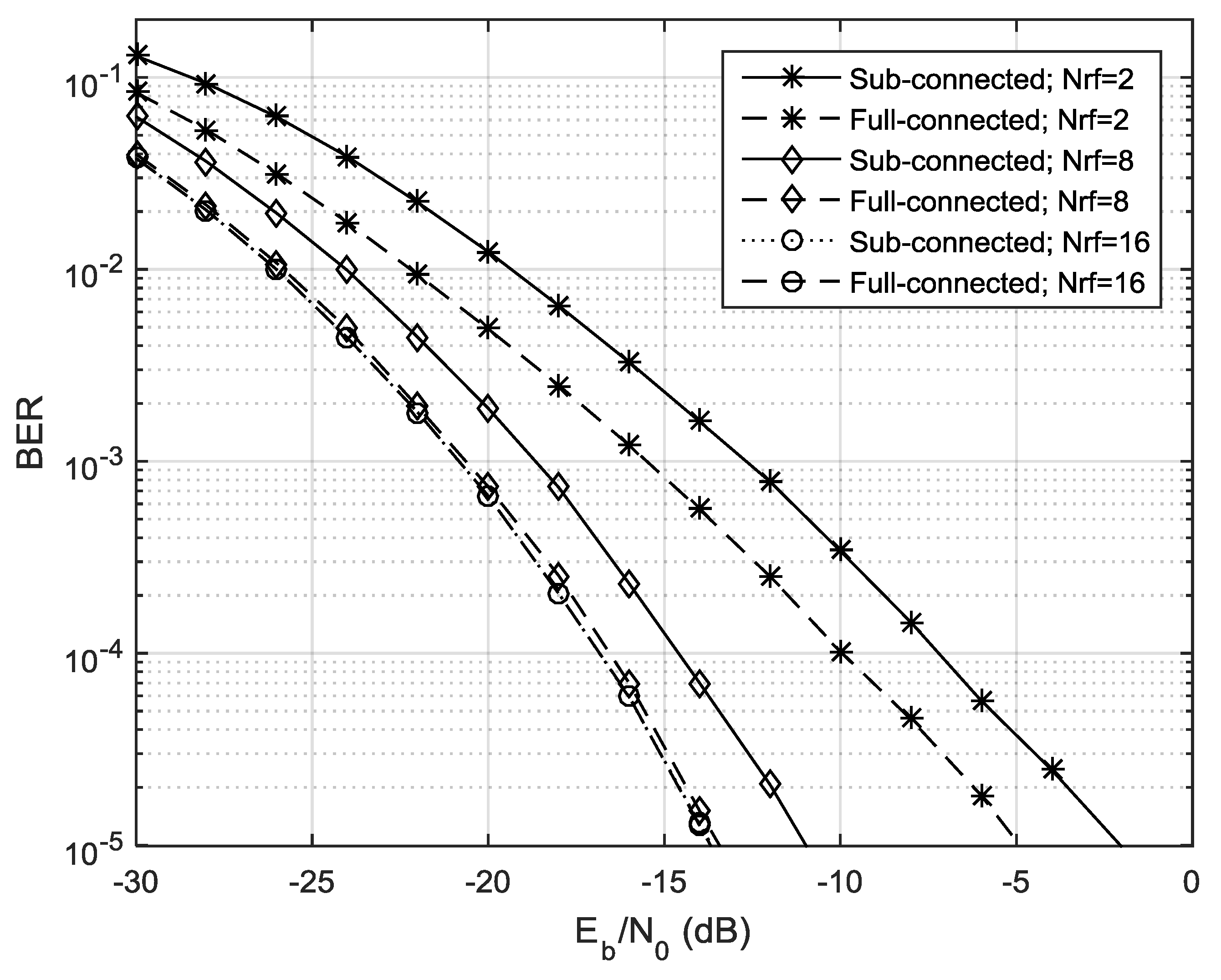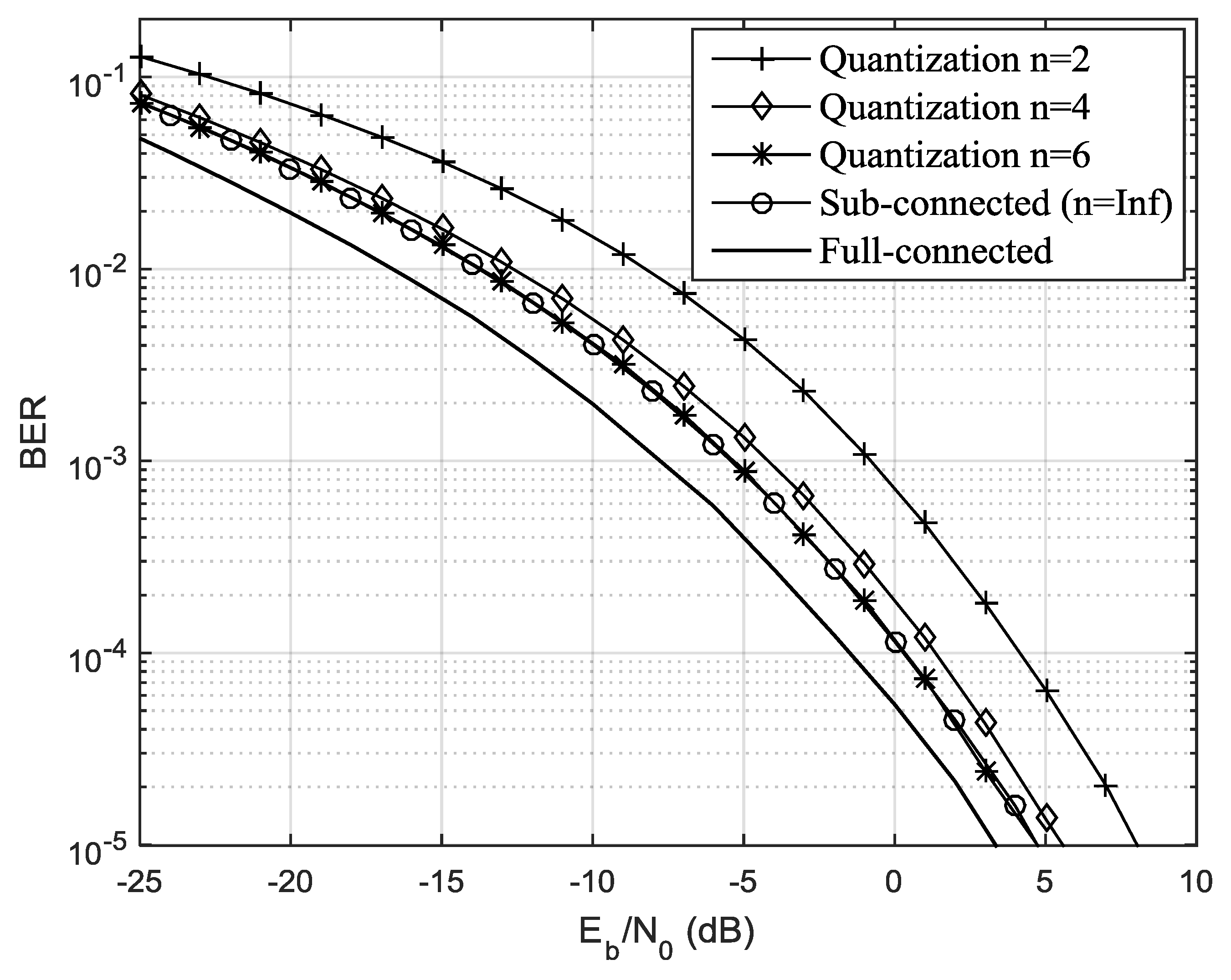Multi-User Linear Equalizer and Precoder Scheme for Hybrid Sub-Connected Wideband Systems
Abstract
:1. Introduction
1.1. Previous Work on Fully Connected Architectures
1.2. Previous Work on Sub-Connected Architectures
1.3. Main Contributions
1.4. Organization and Notation
2. System Model
2.1. Transmitter Description
2.2. Channel Model Description
2.3. Receiver Description
3. Analog Precoder Design
4. Multi-User Equalizer Design
4.1. Problem Formulation
4.2. Proposed Method Derivation
| Algorithm 1: The proposed analog–digital multi-user linear equalizer algorithm for sub-connected architecture |
| Inputs: |
| Analog Part of the equalizer |
| 1: |
| 2: for i = 1 to do |
| 3: |
| 4: |
| 5: |
| 6: for k = 1 to do |
| 7: |
| 8: |
| 9: end for |
| 10: |
| 11: |
| 12: |
| 13: |
| 14: end for |
| Digital part of the equalizer |
| return: , |
4.3. Complexity Analysis
5. Performance Results
6. Conclusions
Author Contributions
Funding
Conflicts of Interest
References
- Demestichas, P.; Georgakopoulos, A.; Karvounas, D.; Tsagkaris, K.; Stavroulaki, V.; Lu, J.; Xiong, C.; Yao, J. 5G on the Horizon: Key Challenges for the Radio-Access Network. IEEE Veh. Technol. Mag. 2013, 8, 47–53. [Google Scholar] [CrossRef]
- Hossain, E.; Rasti, M.; Tabassum, H.; Abdelnasser, A. Evolution toward 5G multi-tier cellular wireless networks: An interference management perspective. IEEE Wirel. Commun. 2014, 21, 118–127. [Google Scholar] [CrossRef]
- Roh, W.; Seol, J.; Park, J.; Lee, B.; Lee, J.; Kim, Y.; Cho, J.; Cheun, K.; Aryanfar, F. Millimeter-wave beamforming as an enabling technology for 5G cellular communications: Theoretical feasibility and prototype results. IEEE Commun. Mag. 2014, 52, 106–113. [Google Scholar] [CrossRef]
- Bogale, T.E.; Le, L.B. Massive MIMO and mmWave for 5G Wireless HetNet: Potential Benefits and Challenges. IEEE Veh. Technol. Mag. 2016, 11, 64–75. [Google Scholar] [CrossRef]
- Swindlehurts, A.; Ayanoglu, E.; Heydari, P.; Capolino, F. Millimeter-wave massive MIMO: The next wireless revolution? IEEE Commun. Mag. 2014, 52, 56–62. [Google Scholar] [CrossRef]
- Pi, Z.; Khan, F. An introduction to millimeter-wave mobile broadband systems. IEEE Commun. Mag. 2011, 49, 101–107. [Google Scholar] [CrossRef]
- Prasad, K.; Hossain, E.; Bhargava, V.K. Energy efficiency in massive MIMO-based 5G networks: Opportunities and challenges. IEEE Wirel. Commun. 2017, 24, 86–94. [Google Scholar] [CrossRef]
- Vu, T.K.; Liu, C.-F.; Bennis, M.; Debbah, M.; Latva-Aho, M.; Hong, C.S. Ultra-Reliable and Low Latency Communication in mmWave-Enabled Massive MIMO Networks. IEEE Commun. Lett. 2017, 21, 2041–2044. [Google Scholar] [CrossRef]
- Han, S.; Lin, C.; Rowell, C.; Xu, Z.; Wang, S.; Pan, Z. Large scale antenna system with hybrid digital and analog beamforming structure. In Proceedings of the 2014 ICC—2014 IEEE International Conference on Communication Workshop (ICC), Sydney, NSW, Australia, 10–14 June 2014; pp. 842–847. [Google Scholar]
- Tan, W.; Matthaiou, M.; Jin, S.; Li, X. Spectral Efficiency of DFT-Based Processing Hybrid Architectures in Massive MIMO. IEEE Wirel. Commun. Lett. 2017, 6, 586–589. [Google Scholar] [CrossRef]
- Roze, A.; Crussiere, M.; Helard, M.; Langlais, C. Comparison between a hybrid digital and analog beamforming system and a fully digital Massive MIMO system with adaptive beamsteering receivers in millimeter-Wave transmissions. In Proceedings of the 2016 International Symposium on Wireless Communication Systems (ISWCS), Poznan, Poland, 20–23 September 2016; pp. 86–91. [Google Scholar]
- Alkhateeb, A.; El Ayach, O.; Leus, G.; Heath, R.W. Channel Estimation and Hybrid Precoding for Millimeter Wave Cellular Systems. IEEE J. Sel. Top. Process. 2014, 8, 831–846. [Google Scholar] [CrossRef]
- Alkhateeb, A.; Mo, J.; González-Prelcic, N.; Heath, R., Jr. MIMO precoding and combining solutions for millimeter-wave systems. IEEE Commun. Mag. 2014, 52, 122–131. [Google Scholar] [CrossRef]
- Ayach, O.; Rajagopal, S.; Surra, S.; Pi, Z.; Heath, R. Spatially sparse precoding in millimeter wave MIMO systems. IEEE Trans. Wirel. Commun. 2014, 13, 1499–1513. [Google Scholar] [CrossRef]
- Gao, X.; Dai, L.; Yuen, C.; Wang, Z. Turbo-Like Beamforming Based on Tabu Search Algorithm for Millimeter-Wave Massive MIMO Systems. IEEE Trans. Veh. Technol. 2016, 65, 5731–5737. [Google Scholar] [CrossRef]
- Ni, W.; Dong, X.; Lu, W.S. Near-optimal hybrid processing for massive MIMO systems via matrix decomposition. IEEE Trans. Signal Process. 2017, 65, 3922–3933. [Google Scholar] [CrossRef]
- Alkhateeb, A.; Leus, G.; Heath, R.W. Limited feedback hybrid precoding formulti-user millimeter wave systems. IEEE Trans. Wirel. Commun. 2015, 14, 6481–6494. [Google Scholar] [CrossRef]
- Sohrabi, F.; Yu, W. Hybrid digital and analog beamforming design for large-scale antenna Arrays. IEEE J. Sel. Top. Signal Process. 2016, 10, 501–513. [Google Scholar] [CrossRef]
- Nguyen, D.H.N.; Le, L.B.; Le-Ngoc, T.; Heath, R.W. Hybrid MMSE Precoding and Combining Designs for mmWave Multiuser Systems. IEEE Access 2017, 5, 19167–19181. [Google Scholar] [CrossRef]
- Magueta, R.; Castanheira, D.; Silva, A.; Dinis, R.; Gameiro, A. Hybrid Iterative Space-Time Equalization for Multi-User mmW Massive MIMO Systems. IEEE Trans. Commun. 2017, 65, 608–620. [Google Scholar] [CrossRef]
- Wang, Z.; Li, M.; Tian, X.; Liu, Q. Iterative hybrid precoder and combiner design for mmWave multiuser MIMO systems. IEEE Commun. Lett. 2017, 21, 1581–1584. [Google Scholar] [CrossRef]
- Sung, L.; Park, D.; Cho, D. Limited feedback hybrid beamforming based on dual polarized array antenna. IEEE Commun. Lett. 2018, 22, 1486–1489. [Google Scholar] [CrossRef]
- Alkhateeb, A.; Heath, R.W. Frequency selective hybrid precoding for limited feedback millimeter wave systems. IEEE Trans. Commun. 2016, 64, 1801–1818. [Google Scholar] [CrossRef]
- Lin, Y. Hybrid MIMO-OFDM beamforming for wideband mmWave channels without instantaneous feedback. IEEE Trans. Signal Process. 2018, 66, 5142–5151. [Google Scholar] [CrossRef]
- Kong, L.; Han, S.; Yang, C. Hybrid precoding with rate and coverage constraints for wideband massive MIMO systems. IEEE Trans. Wirel. Commun. 2018, 17, 4634–4647. [Google Scholar] [CrossRef]
- He, S.; Qi, C.; Wu, Y.; Huang, Y. Energy-Efficient Transceiver Design for Hybrid Sub-Array Architecture MIMO Systems. IEEE Access 2016, 4, 9895–9905. [Google Scholar] [CrossRef]
- Li, N.; Wei, Z.; Yang, H.; Zhang, X.; Yang, D. Hybrid precoding for mmWave massive MIMO systems with partially connected structure. IEEE Access 2017, 5, 15142–15151. [Google Scholar] [CrossRef]
- Gao, X.; Dai, L.; Han, S.; Chih-Lin, I.; Heath, R.W. Energy-efficient hybrid analog and digital precoding for mmWave MIMO systems with large antenna arrays. IEEE J. Sel. Areas Commun. 2016, 34, 998–1009. [Google Scholar] [CrossRef]
- Li, A.; Masouros, C. Hybrid Analog-Digital Millimeter-Wave MU-MIMO Transmission with Virtual Path Selection. IEEE Commun. Lett. 2017, 21, 438–441. [Google Scholar] [CrossRef]
- Magueta, R.; Mendes, V.; Castanheira, D.; Silva, A.; Dinis, R.; Gameiro, A. Iterative Multiuser Equalization for Subconnected Hybrid mmWave Massive MIMO Architecture. Wirel. Commun. Mob. Comput. 2017, 2017, 1–13. [Google Scholar] [CrossRef]
- Hu, C.; Zhang, J. Hybrid precoding design for adaptive sub-connected structures in millimeter-wave MIMO systems. IEEE Syst. J. 2019, 13, 137–146. [Google Scholar] [CrossRef]
- Park, S.; Alkhateeb, A.; Heath, R.W. Dynamic subarrays for hybrid precoding in wideband mmWave MIMO systems. IEEE Trans. Wirel. Commun. 2017, 16, 2907–2920. [Google Scholar] [CrossRef]
- Sohrabi, F.; Yu, W. Hybrid analog and digital beamforming for mmWave OFDM large-scale antenna arrays. IEEE J. Sel. Areas Commun. 2017, 35, 1432–1443. [Google Scholar] [CrossRef]
- Palomar, D.; Jiang, Y. MIMO Transceiver Design via Majorization Theory; Now: Boston, MA, USA, 2007. [Google Scholar]
- Giraud, L.; Langou, J.; Rozložník, M. The loss of orthogonality in the Gram-Schmidt orthogonalization process. Comput. Math. Appl. 2005, 50, 1069–1075. [Google Scholar] [CrossRef]






| Parameter | Values |
|---|---|
| Number of user (U) | 2, 4, and 8 |
| Number of Receive antennas () | 16 |
| Number of Transmit antennas () | 8 |
| Number of RF chains (R) | 2,8, and 16 |
| Number of subcarriers () | 64 |
| Cyclic prefix | 16 |
| Number of quantization bits (n) | 2, 4, and 6 |
| Carrier frequency | 72 GHz |
| Number of clusters () | 5 |
| Number of rays per cluster () | 3 |
© 2019 by the authors. Licensee MDPI, Basel, Switzerland. This article is an open access article distributed under the terms and conditions of the Creative Commons Attribution (CC BY) license (http://creativecommons.org/licenses/by/4.0/).
Share and Cite
Castanheira, D.; Teodoro, S.; Simões, R.; Silva, A.; Gameiro, A. Multi-User Linear Equalizer and Precoder Scheme for Hybrid Sub-Connected Wideband Systems. Electronics 2019, 8, 436. https://doi.org/10.3390/electronics8040436
Castanheira D, Teodoro S, Simões R, Silva A, Gameiro A. Multi-User Linear Equalizer and Precoder Scheme for Hybrid Sub-Connected Wideband Systems. Electronics. 2019; 8(4):436. https://doi.org/10.3390/electronics8040436
Chicago/Turabian StyleCastanheira, Daniel, Sara Teodoro, Ricardo Simões, Adão Silva, and Atilio Gameiro. 2019. "Multi-User Linear Equalizer and Precoder Scheme for Hybrid Sub-Connected Wideband Systems" Electronics 8, no. 4: 436. https://doi.org/10.3390/electronics8040436





